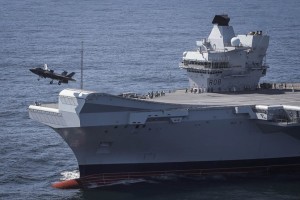The NATO maritime live exercise (LIVEX) Steadfast Defender 2021 began off the coast of Portugal on May 20, featuring the first deployment of the United Kingdom’s newest aircraft carrier.
The U.S. Navy said this exercise’s size and scope will test NATO’s ability to secure strategic and sea lines of communications and move large numbers of troops, equipment and supplies across the Atlantic Ocean and Europe to respond to an exercise scenario.
“The prompt deployment of forces from North America, their movement across the European Continent, and the integration of multinational troops will strengthen the readiness and deterrence posture of Allied Command Operations,” the Navy said in a statement.

This exercise is being led by Joint Force Command Norfolk (JFCNF) and models a rapid reinforcement of NATO’s European members by North American forces. Participating forces include over 5,000 service members, 20 ships and 40 aircraft, including F-35B Joint Strike Fighters embarked on the UK’s HMS Queen Elizabeth.
As this LIVEX features the maiden deployment of the HMS Queen Elizabeth, it will include both U.S. and U.K. F-35Bs, making it the largest air group of fifth generation jets as well as the largest deployment of Fleet Air Arm helicopters in a decade.
In January the U.K. Royal Navy declared the Queen Elizabeth carrier strike group at Initial Operating Capability with all elements brought together and operated. The ground is expected to reach full operating capability by December 2023 (Defense Daily, Jan. 4).
That same month, top U.S. and U.K. defense officials signed an agreement allowing U.S. Navy and Marine Corps personnel to deploy on the new carrier. American F-35Bs are meant to help fill in the ship’s air wing until the U.K. readies more F-35B squadrons (Defense Daily, Jan. 19).
The service said Steadfast Defender is NATO’s flagship exercise this year and set to be the first in a new series of long-planned alliance exercises to ensure forces are trained, able to operate together and ready to respond to threats from various directions.
The overall event is made of three parts in a series of linked exercises. The first part is this maritime LIVEX focused on transatlantic reinforcement. Part two focuses on the enablement of Supreme Allied Commander Europe area of responsibility, military mobility and the deployment of a NATO response force. In the last part, allies and partner nations will participate in various national exercises including redeployment operations to their home stations.
Participating units in this maritime LIVEX include the USS Mount Whitney (LCC-20) as the command and control platform with the embarked U.S. 2nd Fleet Staff; the Royal Navy’s HMS Queen Elizabeth carrier strike group with embarked U.S. Marine Fighter Attack Squadron (VMFA) 211, and cooperative deployers; the Dutch HNLMS Evertsen (F805), USS The Sullivans (DDG-68); the Iwo Jima Amphibious Ready Group; Standing NATO Marine Groups 1 and 2; and various surface ships and aircraft from Canada, France, Germany, Italy, Portugal, Spain, and Turkey.
The 2nd Fleet is acting as the Maritime Component Commander (MCC) for this maritime portion of the exercise, with staff supporting the LIVEX aboard LCC-20.
“The USS Mount Whitney plays a pivotal role with its communications capability. 2nd Fleet’s role as the MCC for the exercise demonstrates the United States’ ironclad commitment to NATO, and the U.S.’s dedication to further revitalize its relationship with the Alliance,” Rear Adm. Steve Waddell, Royal Canadian Navy and vice commander of U.S. 2nd Fleet, embarked aboard Mount Whitney as the leader of the MCC, said in a statement.
“This challenging mission serves to demonstrate the unity of NATO Allies and our readiness to deter conflict and aggression. It showcases our abilities, as an Alliance, to maintain freedom of navigation, rule of law, and to effectively deter adversaries around the globe,” Vice Adm. Andrew Lewis, Commander of JFCNF and U.S. 2nd Fleet, added.
Other components of the exercise will include a serialized program over two seeks allowing allied submarines, surface ships and aircraft to work together to prepare for high-end operations against near-peer competitors.
Additionally, the Iwo Jima Amphibious Ready Group (ARG) is set to integrate into the exercise as an example of alliance integration, with the USS Iwo Jima (LHD-7) and its ARG providing “reach to the MCC for the sea lines of communication protection mission.”